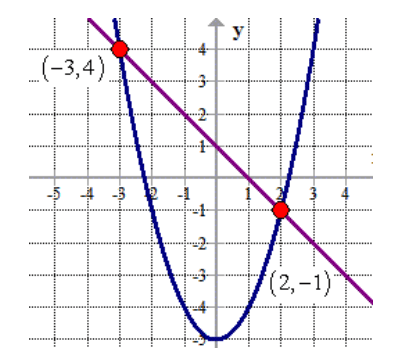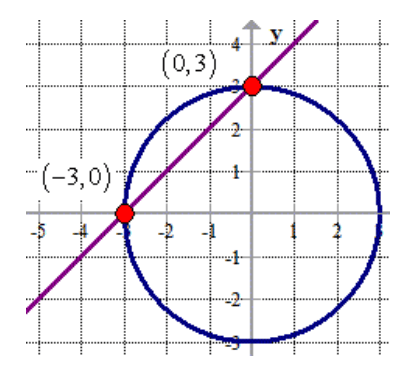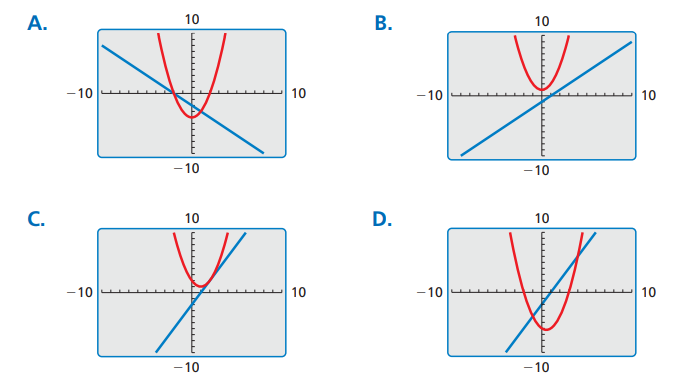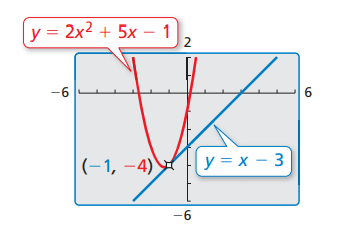Solve Nonlinear System of Equations
A system of nonlinear equations is a system of two or more equations in two or more variables containing at least one equation that is not linear. For example, each of the following systems given below is a system of nonlinear equations.
\(\left\{\begin{array} { l }
{ x ^ { 2 } + y ^ { 2 } = 9 } \\
{ x – y = 9 }
\end{array} \left\{\begin{array} { l }
& { 9 x ^ { 2 } + y ^ { 2 } = 9 } \\
& { y = 3 x – 3 }
\end{array} \left\{\begin{array}{l}
& x+y=4 \\
& y=x^2+2
\end{array}\right.\right.\right.
\)
Example 1: Solve the system by graphing:
\(\begin{aligned}
& x+y=1 \\
& y=x^2-5
\end{aligned}
\)
Solution:
This system has two equations of each kind: linear and nonlinear. Start with the first equation since it is linear. You can solve for \(x\) or \(y\). For this one, let’s solve for \(y\) in terms of \(x\).
\(
\begin{aligned}
x+y & =1 \\
x-x+y & =1-x \\
y & =1-x
\end{aligned}
\)
Substitute the value of \(y\) into the second equation, and then solve for \(x\). In this problem, move everything to one side of the equation while keeping the opposite side equal to zero. After doing so, factor out the simple trinomial and then set each factor equal to zero to solve for \(x\).
\(
\begin{aligned}
y & =x^2-5 \\
1-x & =x^2-5 \\
1-x+x & =x^2+x-5 \\
1 & =x^2+x-5 \\
1-1 & =x^2+x-5-1 \\
0 & =x^2+x-6 \\
0 & =(x+3)(x-2) \\
x+3 & =0 \quad \text { or } x-2=0 \\
x & =-3 \text { or } \quad x=2
\end{aligned}
\)
After solving the equation, we arrived at two values of \(x\). Substitute these numerical values to any of the two original equations. However, pick the “simpler” equation to simplify the calculation. Obviously, the linear equation \(x+y=1\) is the best choice!
Case-I: If \(x=-3\), solve for \(y\).
\(
\begin{aligned}
x+y & =1 \\
-3+y & =1 \\
-3+3+y & =1+3 \\
y & =4
\end{aligned}
\)
Answer: \((-3,4)\)
CaseII: If \(x=2\), solve for \(y\).
\(
\begin{aligned}
x+y & =1 \\
2+y & =1 \\
2-2+y & =1-2 \\
y & =-1
\end{aligned}
\)
Answer: \((2,-1)\)
Therefore, the solution set to the given system of nonlinear equations consists of two points which are \((-3,4)\) and \((2,-1)\).
Graphically, we can think of the solution to the system as the points of intersections between the linear function \(x+y=1\) and quadratic function \(y=x^2-5\).

Example 2: Solve the system of equations below.
\(\begin{aligned}
& x^2+y^2=9 \\
& y=x+3
\end{aligned}
\)
Solution:
The first equation is a circle with a radius of 3 since the general formula of a circle is \(x^2+y^2=r^2\).
What I will do is to substitute the expression of \(y\) which is \(x+3\) from the bottom equation to the \(y\) of the top equation. Then we should be able to solve for \(x\).
\(
\begin{aligned}
& x^2+y^2=9 \\
& x^2+(x+3)^2=9 \\
& x^2+x^2+6 x+9=9 \\
& 2 x^2+6 x+9=9 \\
& 2 x^2+6 x+9-9=9-9 \\
& 2 x^2+6 x=0 \\
& 2 x(x+3)=0 \\
& 2 x=0 \text { or } x+3=0 \\
& x=0 \\
& x=-3 \\
&
\end{aligned}
\)
Use these values of \(x\) to find the corresponding values of \(y\). I would pick the simpler equation (bottom equation) \(y=x+3\) to solve for \(y\).
Case-I: If \(x=0\), solve for \(y\).
\(
\begin{aligned}
y & =x+3 \\
& =0+3 \\
y & =3
\end{aligned}
\)
Answer: \((0,3)\)
case-II: If \(x=-3\), solve for \(y\).
\(
\begin{aligned}
y & =x+3 \\
& =-3+3 \\
y & =0
\end{aligned}
\)
Answer: \((-3,0)\)
The final answers are the points \((0,3)\) and \((-3,0)\). These are the points of intersections of the given line and circle centered at the origin.

Example 3: Solve the following system of equations
\(\begin{aligned}
& 2 x^2+3 y^2=30 \\
& 3 x^2-2 y^2=19
\end{aligned}
\)
Solution:
We will also solve this using the elimination method. However, multiply both of the equations first by some number so that their constants become the same but opposite in signs.
\(\begin{gathered}
4 x^2+6 y^2=60 \\
9 x^2-6 y^2=57+ \\
\hline {13 x^2=117}
\end{gathered}
\)
Now, solve for \(x\) by dividing both sides by the coefficient of the \(x^2\) term, and then performing the square root operation on both sides of the equation.
\(
\begin{aligned}
\frac{13 x^2}{13} & =\frac{117}{13} \\
x^2 & =9 \\
\sqrt{x^2} & =\pm \sqrt{9} \\
x & =\pm 3
\end{aligned}
\)
Back substitute the values of \(x\) into any of the original equations to solve for \(y\).
Let’s use the first equation.
Case-I: If \(x=3\), solve for \(y\).
When \(x=3\)
\(
\begin{aligned}
2 x^2+3 y^2 & =30 \\
2(3)^2+3 y^2 & =30 \\
18+3 y^2 & =30 \\
3 y^2 & =12 \\
y^2 & =4 \\
\sqrt{y^2} & =\pm \sqrt{4} \\
y & =\pm 2
\end{aligned}
\)
Answer: \((3,2)\) and \((3,-2)\)
Case-II: If \(x=-3\), solve for \(y\).
When \(x=-3\)
\(
\begin{aligned}
2 x^2+3 y^2 & =30 \\
2(-3)^2+3 y^2 & =30 \\
18+3 y^2 & =30 \\
3 y^2 & =12 \\
y^2 & =4 \\
\sqrt{y^2} & =\pm \sqrt{4} \\
y & =\pm 2
\end{aligned}
\)
Answer: \((-3,2)\) and \((-3,-2)\)
The solutions to this nonlinear system are the points of intersections of the given ellipse and hyperbola.

Analyzing Systems of Equations
Match each system of equations with its graph.


Solving Nonlinear Systems by Graphing
The methods for solving systems of linear equations can also be used to solve systems of nonlinear equations. A system of nonlinear equations is a system in which at least one of the equations is nonlinear.
When a nonlinear system consists of a linear equation and a quadratic equation, the graphs can intersect in zero, one, or two points. So, the system can have zero, one, or two solutions, as shown

Example 4: Solve the system by graphing.
\(
\begin{aligned}
& y=2 x^2+5 x-1 \\
& y=x-3
\end{aligned}
\)
Solution:
Step 1: Graph each equation.

Step 2: Estimate the point of intersection. The graphs appear to intersect at (−1, −4).
Step 3: Check the point from Step 2 by substituting the coordinates into each of the original equations.
Equation 1
\(
\begin{aligned}
y & =2 x^2+5 x-1 \\
-4 & \stackrel{?}{=} 2(-1)^2+5(-1)-1 \\
-4 & =-4
\end{aligned}
\)
Equation 2
\(
\begin{gathered}
y=x-3 \\
-4 \stackrel{?}{=}-1-3 \\
-4=-4
\end{gathered}
\)